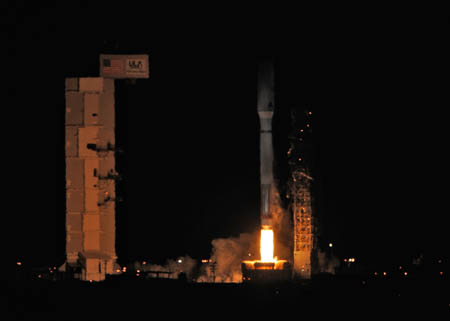 The Air Force and its industry partners launched a National Reconnaissance Office classified payload into orbit aboard a United Launch Alliance Atlas V rocket from Vandenberg AFB, Calif. “This was our 11th launch for 2013 and I couldn’t be more proud of this team of professionals,” said Col. Keith Balts, commander of Vandy’s 30th Space Wing, of the Dec. 5 mission, in a base release. NROL-39 was the last of NRO’s two missions in 2013, according to a release from the agency. It followed NROL-65 in August. The classified payload may be a radar-imaging satellite, reported NASASpaceFlight.com. NROL-39 also featured the Government Experimental Multi-Satellite as an auxiliary payload. GEMSat contained 12 CubeSats, nanosatellites that will perform scientific experiments and demonstrate high-technology operational concepts, according to NRO’s release. Among them is the Air Force’s ALICE payload that features a carbon nanotube array with “great potential for smaller, lighter, and more energy-efficient satellite propulsion,” states the release. GEMSat “represents a significant milestone in accomplishing consistent access to space for advancing novel capabilities,” said Maj. David Illsley, NRO’s overhead solutions branch chief. NRO’s first nanosat rideshare mission was NROL-36 in August 2012.
The Air Force and its industry partners launched a National Reconnaissance Office classified payload into orbit aboard a United Launch Alliance Atlas V rocket from Vandenberg AFB, Calif. “This was our 11th launch for 2013 and I couldn’t be more proud of this team of professionals,” said Col. Keith Balts, commander of Vandy’s 30th Space Wing, of the Dec. 5 mission, in a base release. NROL-39 was the last of NRO’s two missions in 2013, according to a release from the agency. It followed NROL-65 in August. The classified payload may be a radar-imaging satellite, reported NASASpaceFlight.com. NROL-39 also featured the Government Experimental Multi-Satellite as an auxiliary payload. GEMSat contained 12 CubeSats, nanosatellites that will perform scientific experiments and demonstrate high-technology operational concepts, according to NRO’s release. Among them is the Air Force’s ALICE payload that features a carbon nanotube array with “great potential for smaller, lighter, and more energy-efficient satellite propulsion,” states the release. GEMSat “represents a significant milestone in accomplishing consistent access to space for advancing novel capabilities,” said Maj. David Illsley, NRO’s overhead solutions branch chief. NRO’s first nanosat rideshare mission was NROL-36 in August 2012.
The Air Force is requesting about $141 million for initial enlistment bonuses in its fiscal 2026 budget, while Space Force wants $13 million.
